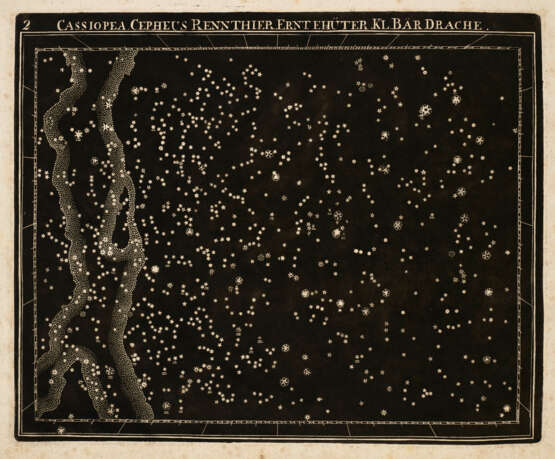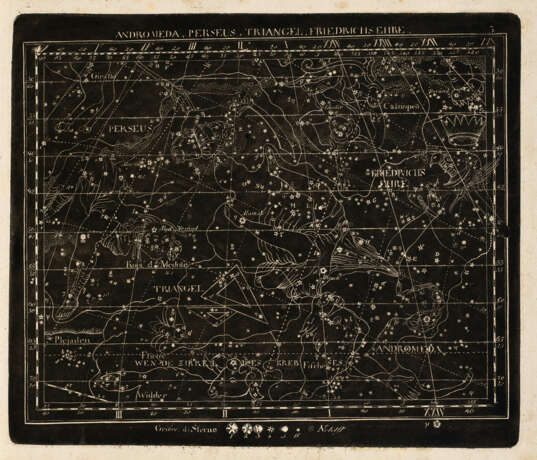ID 887809
Lot 36 | Neuester Himmels-Atlas
Valeur estimée
$ 3 500 – 6 000
Goldbach’s star atlas, a substantially enlarged version of the Bode–Flamsteed atlas of 1782. Over 10,000 stars are shown, about five times as many as in the earlier atlas. The Goldbach atlas consists of 4 hemisphere maps and 52 star charts, the star charts each present in pairs, a traditional version and a parallel one "of the same area showing the white stars on a black background but without co-ordinates, constellations, or other markings. These were intended to simulate the view of the night sky. This pairing was well received by the astronomical community" (Kanas, Star Maps. 2012, pp 184-85).
The pairs of facing plates, with and without constellation figures, weren’t printed from different states or stages of the same plate, as Warner states, but from two separately engraved plates. The stars, constellation figures, scales, etc. are all in relief, that is to say, all of the uninked, white figures on the plates stand in relief, and can be felt (and on the black versos can clearly be seen indented in the paper surface). It is possible that for at least the star figures a metallic punch was used; they don’t appear to be individually engraved.
"Although Goldbach’s atlas was not the first showing white stars against a dark background–Semler, for instance, had used this technique in 1733–it was the first of this kind to catch the eye of the Paris astronomical establishment. Lalande noted that the method succeeded very well; Montucla praised its resemblence to a clear night sky" (Warner). In fact, white-on-black depictions were also used in seventeenth-century astronomical works, but these were done in woodcut, not engraving. Christian Friedrich Goldbach taught astronomy at Moscow University. János Ferenc Zach was a Hungarian astronomer. This is a reissue of the first edition of 1799, with a new title-page added and the original preface reprinted without change. All of the star charts are printed from the original plates, as is the title label on the cover. Warner 96.1
Oblong quarto (228 x 273mm). Text on blue-gray paper (title browned). 4 engraved hemisphere maps and 52 engraved maps on black background (scattered mild spots). Original publisher’s calf-backed boards with oval engraved title label on upper cover.
| Artiste: | Christian Friedrich Goldbach (1763 - 1811) Franz Xaver von Zach (1754 - 1832) |
|---|---|
| Lieu d'origine: | Allemagne |
| Catégorie maison de vente aux enchères: | Livres imprimés |
| Artiste: | Christian Friedrich Goldbach (1763 - 1811) Franz Xaver von Zach (1754 - 1832) |
|---|---|
| Lieu d'origine: | Allemagne |
| Catégorie maison de vente aux enchères: | Livres imprimés |
| Adresse de l'enchère |
CHRISTIE'S 8 King Street, St. James's SW1Y 6QT London Royaume-Uni | |
|---|---|---|
| Aperçu |
| |
| Téléphone | +44 (0)20 7839 9060 | |
| Commission | see on Website | |
| Conditions d'utilisation | Conditions d'utilisation |




